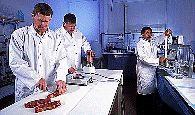United States Department of Agriculture: Agricultural Research Service, Lincoln, Nebraska

Roman L. Hruska U.S. Meat Animal Research Center: Reports
Date of this Version
2012
Document Type
Article
Citation
J. Anim. Sci. 2012. 90:1152–1165; http://dx.doi.org/10.2527/jas.2011-4581
Abstract
The promise of genomic selection is accurate prediction of the genetic potential of animals from their genotypes. Simple DNA tests might replace low-accuracy predictions for expensive or lowly heritable measures of puberty and fertility based on performance and pedigree. Knowing with some certainty which DNA variants (e.g., SNP) affect puberty and fertility is the best way to fulfill the promise. Several SNP from the BovineSNP50 assay have tentatively been associated with reproductive traits including age at puberty, antral follicle count, and pregnancy observed on different sets of heifers. However, sample sizes are too small and SNP density is too sparse to definitively determine genomic regions harboring causal variants affecting reproductive success. Additionally, associations between individual SNP and similar phenotypes are inconsistent across data sets, and genomic predictions do not appear to be globally applicable to cattle of different breeds. Discrepancies may be a result of different QTL segregating in the sampled populations, differences in linkage disequilibrium (LD) patterns such that the same SNP are not correlated with the same QTL, and spurious correlations with phenotype. Several approaches can be used independently or in combination to improve detection of genomic factors affecting heifer puberty and fertility. Larger samples and denser SNP will increase power to detect real associations with SNP having more consistent LD with underlying QTL. Meta- analysis combining results from different studies can also be used to effectively increase sample size. High-density genotyping with heifers pooled by pregnancy status or early and late puberty can be a cost-effective means to sample large numbers. Networks of genes, implicated by associations with multiple traits correlated with puberty and fertility, could provide insight into the complex nature of these traits, especially if corroborated by functional annotation, established gene interaction pathways, and transcript expression. Example analyses are provided to demonstrate how integrating information about gene function and regulation with statistical associations from whole-genome SNP genotyping assays might enhance knowledge of genomic mechanisms affecting puberty and fertility, enabling reliable DNA tests to guide heifer selection decisions.

